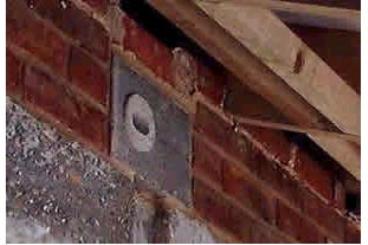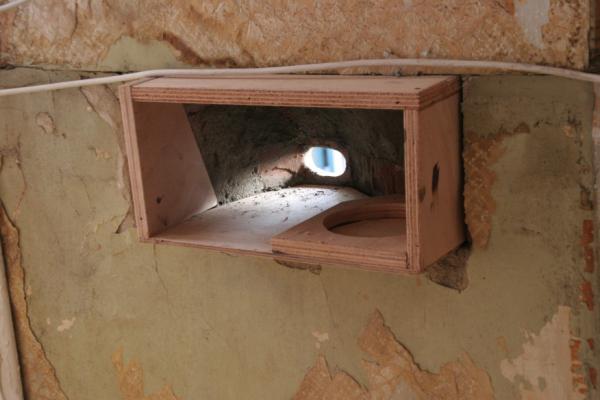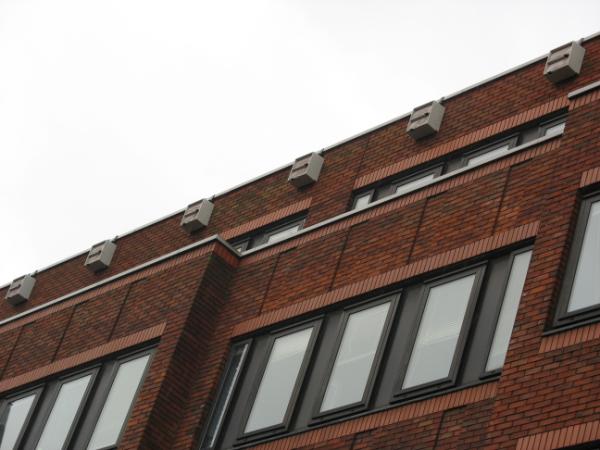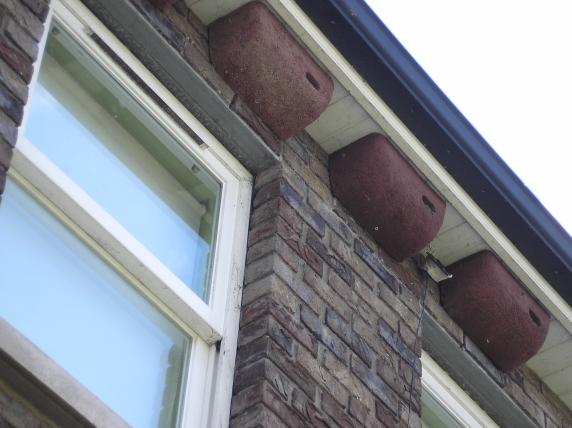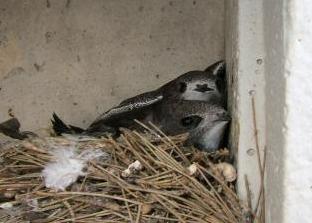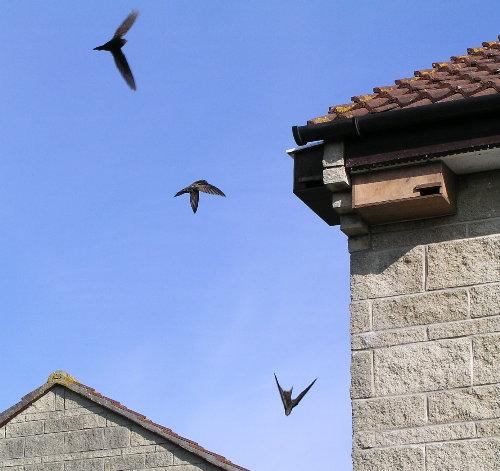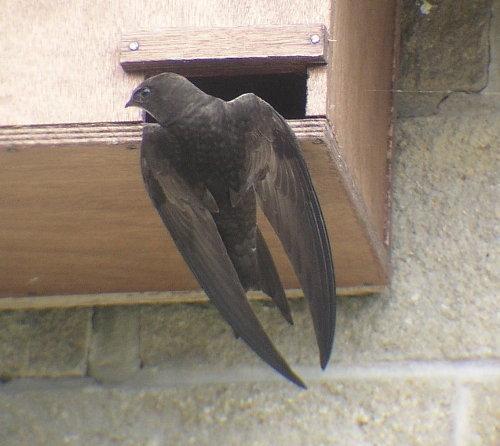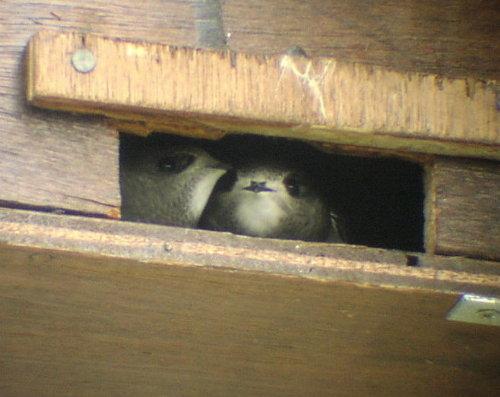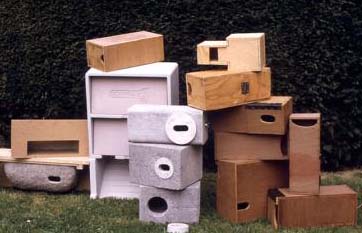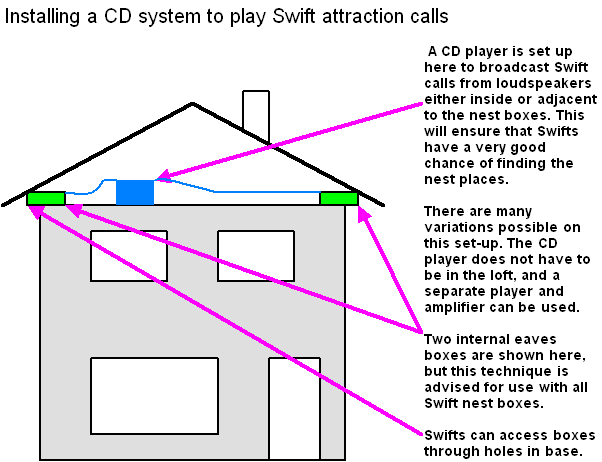 Fitting Swift Nest-places
Fitting Swift Nest-places
|
1
Built in |
|
Built in
is the best way to
create new nest places for Swifts, ensuring longevity, safety and
minimal maintenance needs.
There is a huge variety of ways to
do this, from installing commercial "Swift Bricks" in
blockwork walls, to making dedicated box eaves,
to ingeniously creating
holes in suitable walls. See the pages below for some ideas.
|
|
|
A Swift Brick under the eaves at Horsham Library, West Sussex, a built-in Swift box being installed inside a building in Haarlem, Holland, and the entrance holes to a built-in Swift colony in Kronberg, near Frankfurt. These are simple low-cost ways to provide permanent Swift nest places inside the walls of buildings. Photos © Graham Roberts, Hans Willemsen & Erich Kaiser |
![]() Nest Places inside Eaves - install in both existing and new buildings
Nest Places inside Eaves - install in both existing and new buildings
![]() Nest Places in Pantile Roofs - new or existing
Nest Places in Pantile Roofs - new or existing![]() Nest
Places in Solid Walls - stone, rock, concrete and rubble core
Nest
Places in Solid Walls - stone, rock, concrete and rubble core
![]() Nest
Places in Cavity Walls - new build, or re-built
Nest
Places in Cavity Walls - new build, or re-built
![]() Internal Nest Trays for use behind louvres or openings in towers, spires, high
walls and cupolas
Internal Nest Trays for use behind louvres or openings in towers, spires, high
walls and cupolas
![]() Gable Colonies - make a colony box and set it up behind a gable
Gable Colonies - make a colony box and set it up behind a gable![]() Tower
Colonies - create a colony on an existing tower
Tower
Colonies - create a colony on an existing tower
Retro-fitted
Ready-made Commercial Swift nest boxes
- there's a wide variety of designs to suit most
applications,
both internal and external. There should
be a nestbox suitable for your site.
![]() Click on the Swift to visit
our Shopping! page and select nest boxes
Click on the Swift to visit
our Shopping! page and select nest boxes
|
|
|
| External Swift Nestboxes at Islington Council Offices, London, and on a private house near Antrim. Right, Swift chicks inside a nestbox at the Cathedral in Alcudia, Valencia, Spain. This is a simple way to provide Swifts with nest places on existing buildings. The boxes are bolted to a suitable strong surface high up in locations where the birds won't be disturbed. Photos © E Mayer & J Sanz |
Do
It Yourself
Make
your own nest boxes! Try a design
from the ones below - just click on the Swifts in green squares Advice on choosing a hole type and size for your D-I-Y Swift nest
box
Advice on choosing a hole type and size for your D-I-Y Swift nest
box The Leuven Pattern D-I-Y Under Eaves Swift nest box - highly successful!
The Leuven Pattern D-I-Y Under Eaves Swift nest box - highly successful!
 The Zeist pattern nest box - well proven - and you can download a plan for cutting 8 boxes from one plywood sheet here
The Zeist pattern nest box - well proven - and you can download a plan for cutting 8 boxes from one plywood sheet here Mark Glanville's D I Y twin compartment Swift nest box as seen on
BBC SpringWatch!
Mark Glanville's D I Y twin compartment Swift nest box as seen on
BBC SpringWatch!
 Allan Knight's D I Y single compartment Swift nest box
Allan Knight's D I Y single compartment Swift nest box
![]() D I Y easy to build Swift nesting box with extra
Pipistrelle
Bat roosting space
D I Y easy to build Swift nesting box with extra
Pipistrelle
Bat roosting space
![]() D I Y Quick
& Simple single nest place under-eaves or wall-mounted box - ideal for home use
D I Y Quick
& Simple single nest place under-eaves or wall-mounted box - ideal for home use
![]() D I Y
Triple Swift nest box with ample roosting space at rear for small
bats too
D I Y
Triple Swift nest box with ample roosting space at rear for small
bats too![]() Marcel Jacquat's Simple Swiss-style eaves nest box for deep eaves
Marcel Jacquat's Simple Swiss-style eaves nest box for deep eaves
![]() Bernard Genton's Swiss-style eaves nest box with Sparrow-exclusion door
Bernard Genton's Swiss-style eaves nest box with Sparrow-exclusion door
These D I Y Plans are PDF files and need the Adobe® Reader™ to open.
Download it here 
![]() Need
advice, or a bespoke box design? contact
Swift Conservation
Need
advice, or a bespoke box design? contact
Swift Conservation
|
|
|
|
| DIY plywood
nestboxes at Bradford on Avon in Wiltshire, where
wildlife artist Jonathan Pomroy created his
own Swift colony |
Where to fit Swift Nest Places
- optimum places are under deep eaves, on gables and on high walls in some shade
- not subject to disturbance from window cleaning or maintenance visits
- safe from potential attack by Squirrels, Crows and Magpies i.e. no adjacent perches or creepers
- at least 4.5 metres above ground level
- with uncluttered adjacent airspace for easy flight access
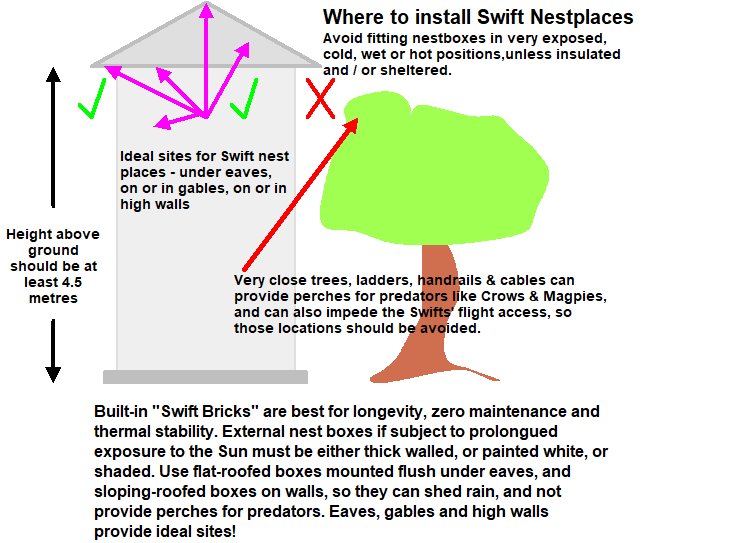
Attracting Swifts using
the Swift Calls CD![]() Order a Swift
Calls CD- see our Shopping Page
Order a Swift
Calls CD- see our Shopping Page
|
|
|
|

